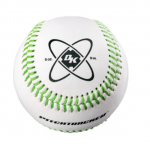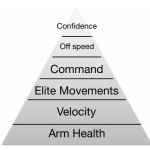Scoring Runs Without Hitting Part IV
Even great players such as Derek Jeter, Albert Pujols, and Alex Rodriguez go through slumps at some point each season. Jeter once went 0-21, Pujols, who is one of the greatest home run hitters of all time, went 110 at bats (almost 1/6 of a season) without hitting a home run, and Arod has gone 0-21 on two separate occasions in his career. Stories like this can sometimes help athletes who may be going through a tough period at the plate themselves.
Young athletes who are in slumps feel as though the pressure of the world is on their shoulder. In the cases of Jeter, Pujols and Arod, there is a lot of external pressure from fans and media, but that is not to say that what your players is dealing with is any less stressful. With young athletes, virtually all of the pressure they feel from a slump is self imposed or is external from parents and coaches. Let’s examine what you can do as a coach or parent to help your athlete break out of a slump.
Most young players will look for something external to blame their slump on. The most common culprits will be the umpires and their equipment. It is important that as a coach you are teaching your players from day one that they should only worry about things they can control, they cannot control the umpire’s calls and should not spend much of their time and effort worrying about them. It is also important that you practice what you preach. If you are telling your players not to worry about umpires, you had better set a good example.
Free eBook on the Top Ten Things Pitchers Must Do
Young players will also look toward their equipment, specifically their bat, as an excuse for their slump. If this is happening, the coach or parent should examine the player’s bat to ensure that it is not too big, too heavy, too short, or too light. If the overall size of the bat fits the player, that is one more thing that we should not allow our players to use as an excuse for their slump. Point out to them recent success they have had with that bat and try to minimize any discussion focused on their equipment as a reason for their struggles.
The fact of the matter is, the slump doesn’t need to be “blamed” on anything. As you have seen above, slumps happen to even the best players. The coach and player should focus their energy on changing whatever may be actually causing the slump. Sometimes it is literally just a string of bad luck. If the player been hitting the ball hard and taking quality, productive at bats, they really aren’t in a slump, they are just not getting results. If this is the case, encourage your hitter to keep doing exactly what he has been doing, he will see positive results eventually.
Players also believe that if they are in a slump they must be doing something mechanically wrong. This is not always the case. It is entirely possible that their swing is exactly the same as it was when they were having more success. If there is something minor that can be adjusted, make that adjustment, but I caution you against making major swing changes during a season when you are playing games on a regular basis. Making the change will be very difficult, and you will likely see a decrease in performance as the change is being made.
In my opinion, the best thing you can do for a slumping player is to help them keep their mind quiet while they are at the plate. One of the simplest things a hitter can think during their at bat is “get a good pitch to hit.” This may be the ultimate culprit of their slump anyways. No matter how quick their hands are, or how flawless their swing mechanics, if they are swinging at bad pitches to hit, they will not be very successful. Likewise, even if a player’s swing is flawed, or they are not the most talented hitter, they give themselves a good chance to hit if they swing at good pitches to hit.
As you can tell, slumps are as much or more mental than they are physical. Your role as a coach or hitting instructor can often be one of a psychologist when dealing with a struggling player. By keeping this one thought in their head and not cluttering their mind with complex swing thoughts, and the external baggage that goes along with a slump, you give your player a good chance of getting back on track and busting out of their slump. This approach can also be used if you have a team that is going through a slump. Instead of trying to correct individual swings, or putting pressure on your team by demanding they improve their performance, simplify everyone’s approach to “get a good pitch to hit.” Emphasize that if they do this, they have had a successful at bat regardless of the outcome.
Summary:
I hope you have enjoyed reading my four part series on how to maximize your offense when your team is not hitting. I will be adding a special, timely post on how to help ensure your player's safety during the extreme heat many of us are dealing with.
More from my site
 CCA Podcast 238 – Maximizing the First 20 Minutes of Practice
CCA Podcast 238 – Maximizing the First 20 Minutes of Practice CCA Podcast 112 – Removing barriers for your players Part 1
CCA Podcast 112 – Removing barriers for your players Part 1 CCA Podcast – Sneak Peek Inside December Q and A
CCA Podcast – Sneak Peek Inside December Q and A CCA Podcast 229 – Pitching Pyramid – Off Speed and Confidence
CCA Podcast 229 – Pitching Pyramid – Off Speed and Confidence Developing an Athlete Centered Coaching Style Part III: Troubleshooting
Developing an Athlete Centered Coaching Style Part III: Troubleshooting CCA Podcast Episode 013: How to steal bases with amazing efficiency
CCA Podcast Episode 013: How to steal bases with amazing efficiency
 Posted by Kyle Nelson
Posted by Kyle Nelson- Posted in Uncategorized
 Dec, 19, 2012
Dec, 19, 2012 No Comments.
No Comments.
Elite members login here
Check out what’s New/Hot!
Recognizing, Diagnosing, and Fixing Common Hitting Flaws eCourse The 3 metrics we tested on Blast motion sensors this year Sneak Peek Inside an Elite Q and A The batting practice continuum Elite Member’s area table of contents 50+ “Chaos” hitting drills
5 sample Chaos hitting drills FREE
Mental Skills and Culture Building The hitting pyramid Welcome Elite Member, Trey! Ideas for a pitcher first practice 12 week bat speed improvement plan Make plans this offseason to have your team playing their best baseball at the end of the year” Top 5 hitting drills to translate practice skill to game performanceHow we used Blast Motion sensors with a team in 2019
What to do if your hitters are overmatched Welcome Elite Member, Tommy! Setting your baserunners up for success Welcome Elite Member, Mike! A consulting call with Elite Member Matt FREE Web Clinic: Developing Athletic, Consistent, Extraordinary Infielders
 Coach Kyle Nelson
Coach Kyle Nelson